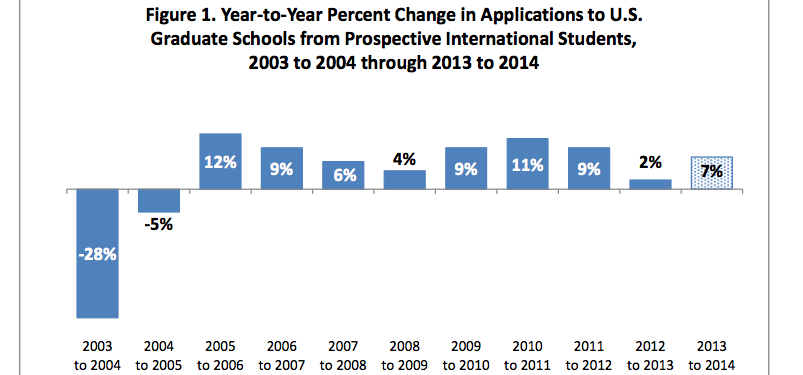Numbers of applications to US graduate schools have increased by 7% despite a 1% drop from the US’s largest international graduate student source country, China. The gain has instead been lead by double-digit growth from Indian students for the second year in a row, according to data from the Council of Graduate Schools (CGS).
News and business analysis for Professionals in International Education
Have some pie!
India drives 7% increase in US graduate applications

International students account for 15% of all graduate students in the US compared to just 4% of the total higher education population.
This year’s increase is a recovery after just 2% growth in 2013 and is more consistent with growth trends from 2006-2012 after the post-September 11 drop, says CGS.
However, growth was inconsistent across student markets with figures from China dropping again after a 3% fall in 2013. Similar to last year, the decline was counterbalanced by a 32% surge in numbers from Indian students after a rise of 22% in 2013.
“Unfriendly visa policies” in the UK is a possible reason for the boom in Indian applications over the past two years
CGS says the imbalance is of particular concern “given the fact that prospective students from India have not exhibited large and sustained year-to-year increases in applications in the same way that prospective students from China have”.
With Chinese students making up 33% of total international graduate enrolments and Indian students 18%, the report warns against over reliance on a handful of markets for student recruitment.
“Continued declines in applications from prospective students from China could ultimately begin to lead to decreases in overall applications from international students to U.S. graduate schools,” it says.
The data, part of a three-phased annual survey of international graduate student applications, admissions and enrolments, is the only real-time measurement of international graduate students in the US and gives an idea of what lies ahead for 2014.
Speaking with The PIE News, CGS President Debra Stewart explained that “applications are important because they’re an early indicator generally of what the talent is that you’re going to be able to select from for admission to graduate schools and therefore how many people are going to come.”
She attributes “unfriendly visa policies” in the UK as a possible reason for the boom in Indian applications over the past two years.
“We don’t have any surveys which tell us that but we do know that immigration policies make a difference not only because it’s the actual number of students that ultimately admit but also it’s the signalling, the messages that they send,” she said.
The slowdown from China represents an overall decline in growth from Asia possibly due to a cool down of economies in the region says Stewart.
Applications from other top five source countries, South Korea and Taiwan, decreased for a third straight year, 5% and 4% respectively.
In Latin America, the numbers were up thanks to a 33% increase from Brazilian applications, after 25% growth last year, and 3% gains from Mexico after a fall of 8% in 2013.
Steweart credits the US’s strength in STEM and Business education for the upward trend in application numbers. The three most popular fields of study—engineering, physical and earth sciences, and business—which together account for 64% of all international students enrolled in US graduate programs, were also the fastest growing, at 14%, 16%, and 7%, respectively.
This year’s increase is a recovery after just 2% growth in 2013 and is more consistent with growth trends from 2006-2012 after the post-September 11 drop
“The reason we’ve had this continued growth over decades in international students is because our graduate programmes are really strong and the STEM and Business programmes are really strong,” she said.
“While I hope in the US we can always compete on quality we recognise and value the fact that good graduate education is really much more broadly spread around the world than it once was.”
Despite concerns that the quality of graduate programmes in competitor countries is improving, Stewart adds that the global demand for education is increasing the talent pool from which schools can recruit.
“We now have more people educated in the undergraduate world than we ever have had with dramatic increases particularly in Asian countries. These are big populations,” she said. “When you increase those numbers you’re just going to have more talent applying for graduate schools around the world for everybody.”
Still looking? Find by category:



9 Responses to India drives 7% increase in US graduate applications